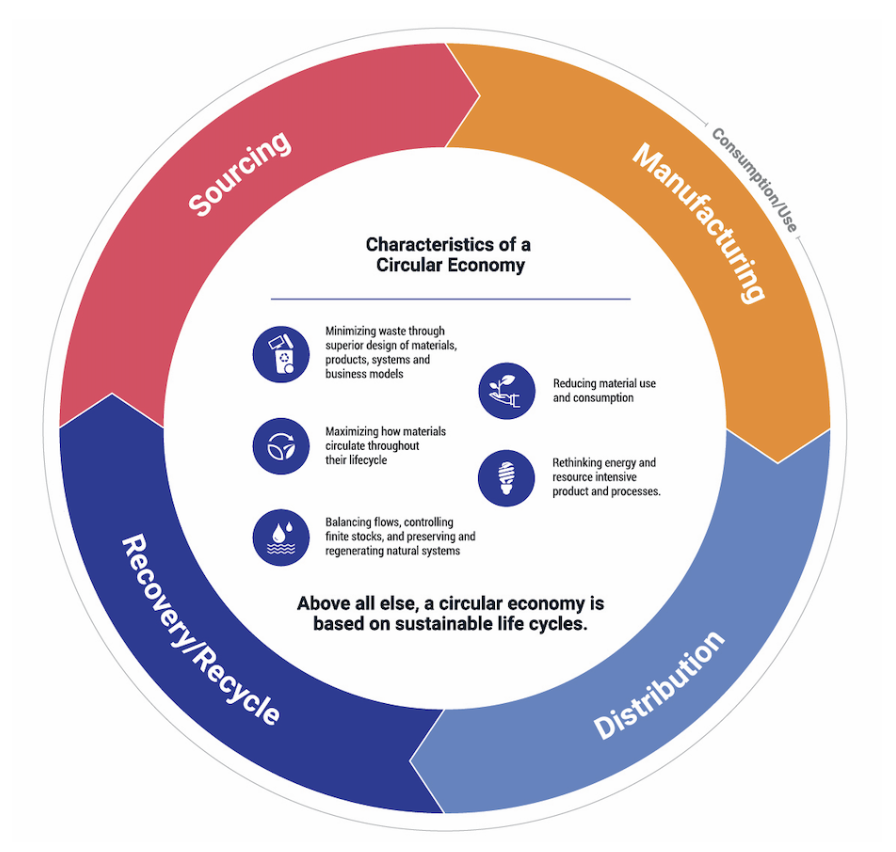By ESG Analyst Tilley Woodford

Overview
The United Nations environmental program draws attention to the roles of businesses in transitioning from a linear to a circular economy. The linear economy structure has had many negative impacts on the environment and social welfare. For example, the growth of the linear economy has accelerated the combustion of fossil fuels, thereby contributing to the anticipated 2.8°C global temperature rise by the year 2100. The wastefulness and extreme resource extraction promoted by a linear economy model has pushed planetary boundaries, significantly diminishing the resources available. This has resulted in 70% of global biodiversity loss and has triggered an increased frequency of natural disasters. The circular economy model views waste as new material and uses creative thinking to recycle and rework used materials to produce new goods or to improve existing goods. Additionally, the circular economy focuses on detaching economic growth from the use of natural resources, highlighting that the rational use of resources and limiting the environmental impact of manufacturing activities can still produce a profitable venture. This process advocates keeping goods in the economic cycle as long as possible by innovatively extending the life cycle of products. Whereas the linear production model produces a lot of waste because in this view once a product is broken, used, or no longer needed it will be disposed of, thus reducing the life cycle of the product and increasing waste.
How to Transition from a Linear Economy to a Circular Economy
There are multiple strategies that can be employed to help transition from a linear to a circular economy. As exemplified by the infographic above, there are nine ‘R’ strategies that can be utilized: Refuse, Rethink, Reduce, Re-use, Repair, Refurbish, Remanufacture, Repurpose, Recycle, and Recover. These nine strategies are linked to three areas of improvement in the value chain, including, smarter functioning supply chains, extending the lifespan of products, and society and lifestyle components. Transitioning from a linear model to a circular model is not just about recycling and considering the environmental impacts of manufacturing; it requires corporations to completely rethink their value proposition, supply chains, and production methods. A thorough assessment of the product’s impact throughout its life cycle is essential, and
innovative solutions must be devised to achieve a sustainable and closed-loop system.
The Value of a Circular Economy
A circular economy produces valuable outputs, including competitive earnings, new economic models, and sustainable solutions. Investors, researchers and companies recognize that commiting to a circular economy produces unique opportunities to promote sustainability, commit to corporate social responsibility, and find creative alternatives to existing manufacturing methods. Most importantly the circular economy is a significant step towards creating a more sustainable world for future generations by addressing climate change, biodiversity loss, resource scarcity and social issues. On the business side, a circular economy reduces raw material costs and allows consumers to access products at lower prices. In relation to food security, the circular model ensures that food waste is properly dealt with and that the land is able to regenerate to make future crops. According to analysis done by the Ellen MacArthur Foundation, if the circular economy model were implemented in Europe across the transport, building and food sectors, an additional EUR $900 billion would be created by 2030. This value is comprised of the cost savings for businesses and customers.
Links:
https://wedocs.unep.org/bitstream/handle/20.500.11822/36830/RBMLCE.pdf?sequence=3
https://www.visualcapitalist.com/sp/visualized-the-circular-economy-101/ https://www.ellenmacarthurfoundation.org/how-does-the-circular-economy-create-value
